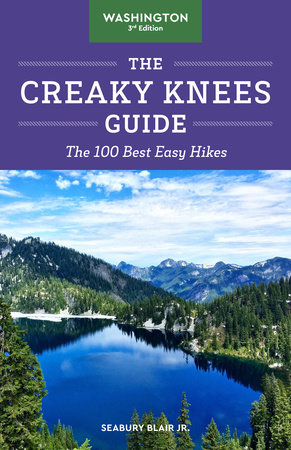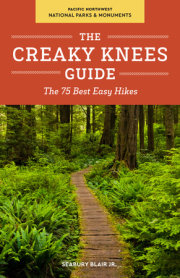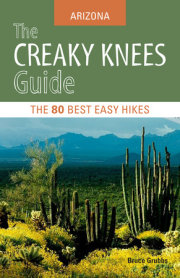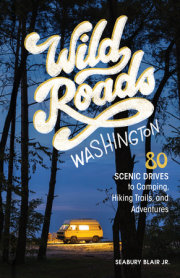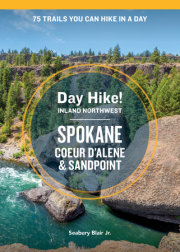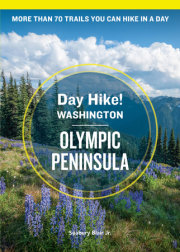IntroductionAs you read these lines, I’ll be celebrating my eighth decade on this planet by taking many of the hikes outlined in this book. I’ve been incredibly lucky to have avoided most of the maladies and ailments that cause those of us who love nature to curse our joints and bones for keep-ing us from the wild places, the places our hearts yearn to see once more. Yet I’m not immune to the greatest handicap of all—advancing age—and that has altered my approach to wilderness pathways, both mentally and physically.And it has changed the way I reviewed the hikes in this, the third edition of The Creaky Knees Guide: Washington. With few exceptions, the hikes and trails have not changed, but I’ve tried to look at them from the standpoint of a wilderness pedestrian who can no longer hike 3 miles an hour for 17 hours straight across the Olympic Mountains, which I did three decades ago; or climb 8 miles and 3,700 vertical feet up Scotchman Peak, which I did four years ago. Both are but minor accomplishments compared to the many folks, older than me, who gallop from one side of the Grand Canyon to the other in a single day, or zip up Denali with minimal support. Still, we all tend to accept the reality that we can’t enjoy our wild world the way we used to, while clinging to the wish that we could.So that was my focus in revising this guide. Wherever I thought it necessary, I mentioned the fact that you needn’t walk the trail as far as I suggest. In most cases, it’s an arbitrary destination and has little to do with the scenery, flora, or fauna you’ll see along the way. Far more important, it seems to me, is getting on the trail, no matter the distance you travel. The forest you enter at the trailhead is the same as that five miles away; the river you walk beside is no wilder a half-mile from the parking area as it is three miles up- or downstream. All of our wild places are just as beautiful, just as magnificent, just as wild a few hun-dred steps up the trail as they are a few miles along.It doesn’t matter how far you walk or how fast you walk, or even if you walk—I’ve paid special attention to pointing out accessible trails— I think what really matters is that you walk. Or hobble, limp, wheel, or—my favorite mode of trail travel these days—waddle.Since I started hiking Washington’s wilderness pathways, shortly after the last ice age, I’ve been both encouraged and saddened by the fact that more people are using the trails these days. In 1968, it was a surprise on a summer weekend to find more than a dozen people hiking to Snow Lake from Snoqualmie Pass, although the trail at that time was a couple of miles longer. Today, you are fortunate to find a parking space in the huge lot near Alpental. Some trailheads are so crowded that hikers are forced to park parallel along the approach road, forcing forest managers to enforce limits or require permits.What good can come of overcrowding? Every person experiencing a wilderness outing for the first time could become an advocate for trails in the future. I hope they will join a growing constituency of users, folks dedicated to improving trails and managing our wild pathways in a manner that alleviates the impact of increased use. Such organi-zations at the Washington Trails Association, The Mountaineers, Sierra Club chapters, Back Country Horsemen of Washington, and Evergreen Mountain Bike Alliance all join with national and state wilderness managers to improve and protect our trails.Washington trails provide rare diversity in the places we can hobble, limp, wheel, or waddle. As diverse as they are, they all share at least one element: exceptional beauty. The mossy, fern-festooned rain forests of the Hoh. The receding glaciers of Mount Adams. The alpine meadows of Hurricane Ridge. The sage and sand of the Columbia Plateau. The ocean-like expanse of the Palouse. All of these places look about the same from mile marker one to mile three and perhaps beyond.The pedestrians who ply our pathways from west to east and north to south are pretty much the same. They all know and love the country at their back door—be it forest or flatland, mountain or meadow, desert or river. I’ve waddled beside a 95-year-old hiker on a Mount Baker trail, encountered a 52-year-old woman jogging through pines along the Spokane River, and passed Real Mountain Climbers toting a football to the summit of Mount Adams for a pickup game. All told me about their favorite trail or hike and spoke about the beauty of the country around them.All the people I met who hike the wild pathways of Washington—from the college kids climbing out of the Salmo-Priest Wilderness to the 89-year-old hiker on the Chain Lakes Trail—will tell you the same thing: walking is the best thing you can do for your soul and your body—especially if you are surrounded by the beauty you can find around our neck of the woods. Age and physical condition are sim-ply not as important to them as getting outside to see what surprises Mother Nature has for them. It is in that spirit that I offer this guide to all of you. Sooner or later, we all realize that “easy hike” is a relative term. What might be an easy hike when you are 22 years old is not likely to merit that same adjective when you are 52 and the vigor has morphed into varicose veins. So while the 100 hikes outlined in this guide are all labeled “easy,” you are likely to find yourself wondering at least once if I am already senile. If you feel—as I often do when trying to keep up with my wife, B. B. Hardbody—like a leaking hydration pack, I’ll be happy. In fact, if you don’t curse your humble correspondent at least once while sweating up a hill or limping back to the trailhead, I have failed in my mission. Don’t be fooled by the title. Unless you are a retired Olympic athlete or can still jog a dozen miles in under an hour, you’ll find plenty of hikes in this guide to keep your heart rate up and your lungs sucking harder than a Dyson. I’ve been lucky in my eight decades on this planet to stay healthy enough to keep walking, and in those years, I have met hundreds of people on the trail who aren’t as fortunate as me. My recent hiking partners include a woman who speeds through the forest on an artifi-cial hip and a group of Washington Trail Association volunteers who appear to take great pleasure in lifting heavy rocks and digging path-ways along basalt cliffs. The important thing, it seems to me, is that regardless of age or physical condition, you try one of the trails out-lined here, walking, wheeling, limping, hobbling, or even waddling through rare beauty and solitude.
Copyright © 2022 by Seabury Blair Jr.. All rights reserved. No part of this excerpt may be reproduced or reprinted without permission in writing from the publisher.





